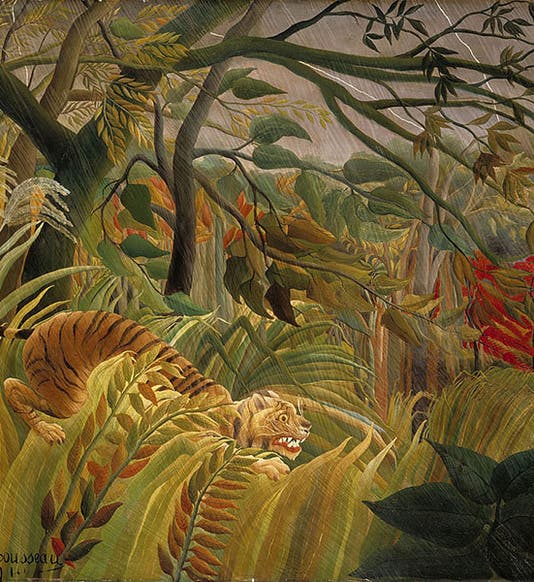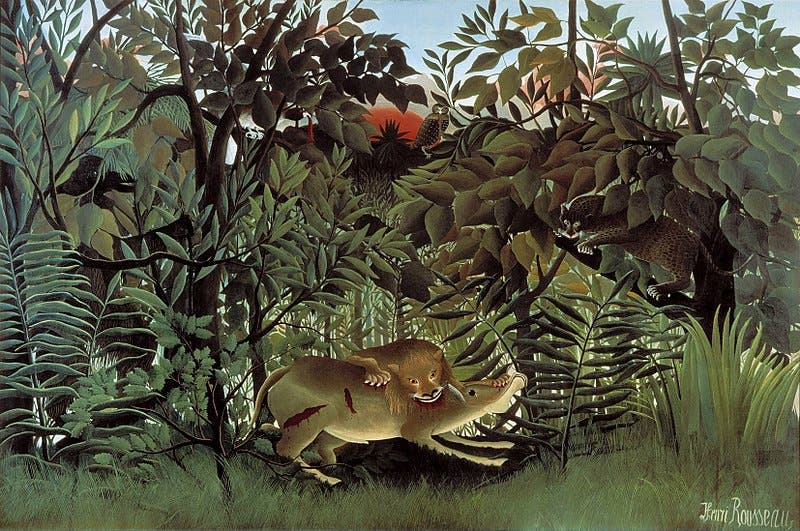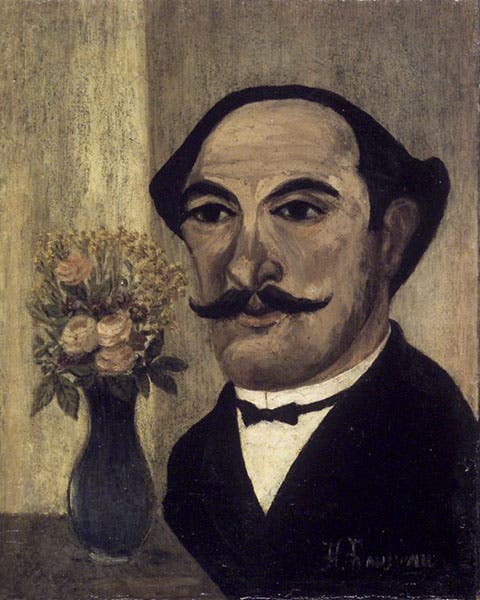Scientist of the Day - Henri Rousseau
Henri Rousseau, a French painter, was born May 21, 1844. We occasionally include artists in our posts about scientists, provided that their art had some connection to science, perhaps depicting new technology, as with J.M.W. Turner, or portraying animals that the artist might have encountered in zoos or natural history books, as with Eugène Delacroix. We are adding Rousseau to their ranks because he liked to paint jungles inhabited by fierce predators. Since he had never seen a jungle, he found his inspiration in the exotic gardens of the Jardin des Plantes in Paris, and the associated Museum of Natural History. Rousseau painted his first jungle in 1891, when he was 47 years old (first image above), Tiger in a Tropical Storm (Surprised!, in the National Gallery in London. The surprise of the tiger must have paled before the surprise of viewers in the Salon where the painting was first displayed.
Rousseau earned his living as a customs inspector and tax collector (hence the nickname, Le Douanier), and taught himself to paint in mid-life, inventing a naive style that had little parallel at the time and attracted a great deal of derision from critics throughout most of his painting career.
But he also attracted some approval, from the people that count, fellow artists such as Pablo Picasso and Robert Delaunay and Juan Gris, and the writer Guillaume Apollinaire, who were trying to break away from academic art and literature themselves, and who admired Rousseau's naïve and open but colorful style. Rousseau retired from customs work when he could, and while he hardly made a living from his art, he did pursue it with a passion, right up until The Dream, in the Museum of Modern Art, which he finished shortly before his death in 1910 (fifth image, below).
What appeals to me about Rousseau’s art is the way he constructed his jungles leaf by leaf, making them rich and lush, but not dense like the real jungle. The same is true with the one non-jungle scene we include, The Flamingoes (1907), where a few lotuses and flamingoes, and some palm trees, suffice to define the space (fifth image, just below). The other paintings included here are just ones that I like, often for no reason that I can spell out.
One can find photographs of Rousseau, but it is much preferable to see him the way he saw himself, in one of several self-portraits that he painted around 1900 (sixth image, below). This one is in the Brooklyn Museum.
After Rousseau's death, the sculptor Constantin Brâncusi created a simple memorial stone, on which he engraved a poem by Apollinaire (seventh image, below). Rousseau was buried in the Bagneux Cemetery on the Île-de-France in Paris. I would translate the epitaph, but frankly, it looks much better than it reads, so we will leave it this way.
Dr. William B. Ashworth, Jr., Consultant for the History of Science, Linda Hall Library and Associate Professor emeritus, Department of History, University of Missouri-Kansas City. Comments or corrections are welcome; please direct to ashworthw@umkc.edu.









![Andromeda and Perseus, constellations figured by James Thornhill, with star positions determined by John Flamsteed, in Atlas coelestis, plate [15], 1729 (Linda Hall Library)](https://assets-us-01.kc-usercontent.com:443/9dd25524-761a-000d-d79f-86a5086d4774/1b30cfec-5be6-4297-a7fb-97255ba992e5/thornhill1.jpg?w=210&h=210&auto=format&fit=crop)


